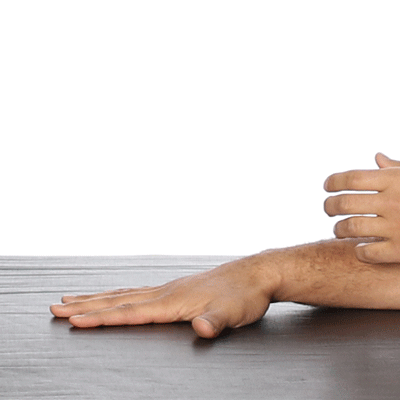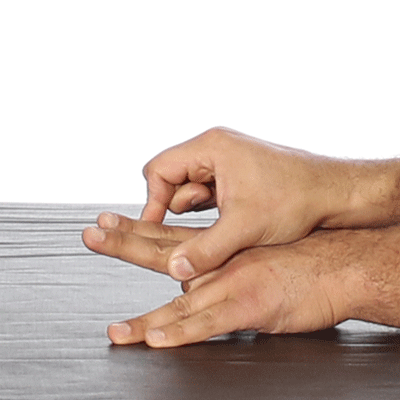Performing targeted exercises and stretches can help to alleviate trigger finger symptoms and increase flexibility. It’s important that you do the exercises consistently in order to get the best results.
The inflammation that causes trigger finger can lead to pain, tenderness, and limited mobility.
Other symptoms include:
- heat, stiffness, or persistent pain at the base of your affected thumb or finger
- a bump or lump at the base of your finger
- a clicking, popping, or snapping noise or sensation when you move your finger
- inability to straighten your finger after bending it
These symptoms may affect more than one finger at a time and on both hands. Symptoms may also be more pronounced or noticeable in the morning, when picking up an object, or when straightening your finger.
Read on to learn how to do trigger finger exercises correctly.
These are simple exercises that can be done anywhere. The only things you’ll need are an elastic band and a variety of small objects. Objects can include coins, bottle tops, and pens.
Try to spend at least 10 to 15 minutes a day performing these exercises. You can increase the amount of time you spend doing the exercises as you gain strength. You can also increase the number of repetitions and sets.
It’s okay if you can’t complete the full range of motion for the exercises! You should only do as much as you can. If your fingers feel sore for any reason, it’s okay to take a complete break from the exercises for a few days or until you feel better.
- Lay your hand out flat on a table or solid surface.
- Use your other hand to hold the affected finger.
- Slowly lift up the finger and keep the rest of your fingers flat.
- Lift and stretch the finger as high as it will go without straining.
- Hold it here for a few seconds and release it back down.
- You can do this stretch on all of your fingers and your tfhumb.
- Do 1 set of 5 repetitions.
- Repeat 3 times throughout the day.
- Place your hand in front of you.
- Extend your affected finger and a normal finger next to it.
- Use your thumb and index finger from the opposite hand to gently press your extended fingers together.
- Use your index finger and thumb to apply a bit of resistance to your two fingers as you separate them.
- Hold here for a few seconds and then return to the starting position.
- Do 1 set of 5 repetitions.
- Repeat 3 times throughout the day.
- Move your affected finger as far away as possible from your nearest normal finger so that they form a V position.
- Use your index finger and thumb from your opposite hand to press these two fingers against the other fingers.
- Then press the two fingers to move them closer together.
- Do 1 set of 5 repetitions.
- Repeat 3 times throughout the day.
- Begin by pinching the tips of your fingers and thumbs.
- Put an elastic band around your fingers.
- Move your fingers away from your thumb so that the band becomes tight.
- Extend your fingers and thumb away and close to each other 10 times.
- You should be able to feel the slight tension of the elastic while you’re doing this.
- Then bend your fingers and thumb towards your palm.
- Hook the elastic band in the middle.
- Use your opposite hand to pull the end of the band to create slight tension.
- Keep the tension as you straighten and bend your fingers 10 times.
10. Repeat at least 3 times throughout the day.
- Pick up a small item and put it in your palm.
- Squeeze tightly for a few seconds.
- Then release by opening your fingers wide.
- Repeat a few times.
- Do it at least two more times during the day using different objects.
- Place a large assortment of small objects such as coins, buttons, and tweezers on a table.
- Pick up one object at a time by grasping it with your affected finger and thumb.
- Move the object to the opposite side of the table.
- Repeat with each object.
- Continue for 5 minutes and do this twice a day.
- Place a sheet of paper or small towel in the palm of your hand.
- Use your fingers to squeeze and scrunch the paper or towel into as small of a ball as possible.
- Apply pressure to your fist while you’re squeezing and hold this position for a few seconds.
- Then slowly straighten your fingers and release the paper or towel.
- Repeat 10 times.
- Do this exercise twice a day.
- Bring your affected finger to your thumb to form an “O” shape.
- Hold here for 5 seconds.
- Then straighten your finger and bring it back to the “O” position.
- Repeat 10 times at least twice a day.
- Start by lightly massaging the area at the base of the affected finger.
- Then make a fist as you bring all of your fingers together.
- Open and close your fist for 30 seconds.
- Then straighten the affected finger and bring it back down to touch your palm.
- Continue this movement for 30 seconds.
- Alternate between these two exercises for 2 minutes.
- Do this exercise 3 times per day.
- Spread your fingers as wide as possible.
- Bend your fingers so that your fingertips touch the top of your palm.
- Straighten your fingers again and spend them wide.
- Then bend your fingers to touch the middle of your palm.
- Open your fingers wide.
- Now bring your fingertips to touch the bottom of your palm.
- Then bring your thumb to touch each fingertip.
- Bring your thumb to touch different places on your palm.
- Do 3 sets twice a day.
- Spread your fingers as wide as possible and hold for a few seconds.
- Then squeeze your fingers close together.
- Now bend all of your fingers backward for a few seconds, and then forward.
- Place your thumb upright and gently draw the thumb back for a few seconds.
- Repeat each stretch several times.
- Do these stretches at least twice per day.
It’s also recommended that you practice self-massage to help treat trigger finger. This can be done for a few minutes at a time throughout the day.
It’s especially beneficial for you to massage the affected finger before and after these exercises. Massaging will help to increase circulation, flexibility, and range of motion.
To do this:
- You can massage or rub in a gentle circular motion.
- Apply firm but gentle pressure.
- You can massage the joint and entire area that’s affected by trigger finger or focus on specific points.
- You can press and hold each point for about 30 seconds.
You may wish to massage your entire hand, wrist, and forearm, as all of these areas are connected. You can decide which method feels best and achieves the best results.
You should start to see improvements within a few weeks to six months of consistent exercise. If you’ve done the exercises regularly and you haven’t seen improvement, or if your symptoms start to get worse or are severe, you should see your doctor. These exercises do not work with all patients and medical treatment and even surgery is often necessary.


